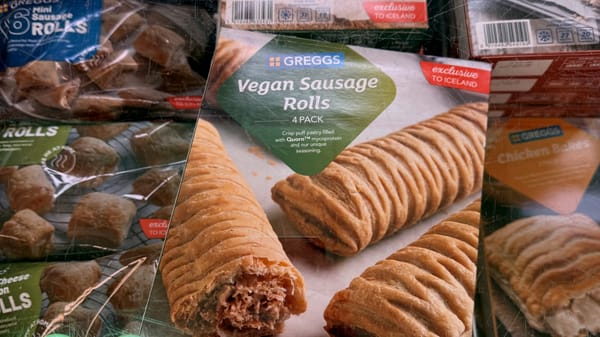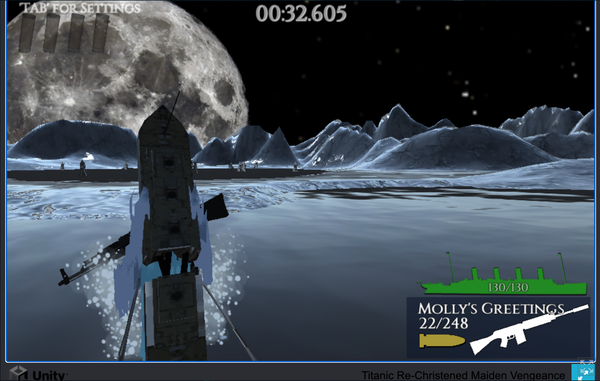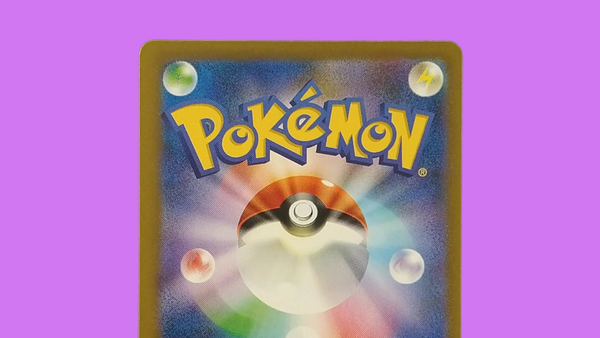Night Water: Year One
A quantitative look at the first year of this newsletter

On Saturday, February 12, Night Water turned one year old. A little over a year ago, I sent the first post, about my perpetual obsession with Babyland General Hospital, to just 15 subscribers. Today, I'm sending this email out to almost 170 people.
I started writing Night Water because I wanted to give myself a reason to write something every week. Over time, the idea of Night Water as a publication has gotten more clear: as of this moment in time, Night Water is a late night and refreshing pop culture newsletter. Late night, because it comes out at 11 p.m. eastern, and refreshing, because the topics and tone are a bit off-center, both familiar and unexpected, like a nighttime glass of water straight from the fridge.
This post looks back at the numbers behind the first year of Night Water: subscriber growth, popular posts, and SEO efforts. While I’m not an expert in newsletter writing, and Night Water isn’t the most massive newsletter in the world, I do hope it is somewhat illuminating and helpful to both my readers and other newsletter writers alike.
But first: did I actually write something every week?
No, but I did alright! In the first year of Night Water, I published 43 posts. Two of those were guest posts, five of those were Night Water Cooler discussion threads, and one was a podcast episode, so that leaves me with 35 new written pieces. That puts me at 67% of my goal.
I had a rough start in the beginning, but two big changes helped me publish more consistently:
- I decided on a standard publish date and time.
- I made a simple content calendar where I could map out the next three months of posts.
This made it a lot easier for me to plan my writing every week. Plus, I could look at the next few weeks in advance and plan topics based on how busy my life was and how much time I'd have to write.
For year two, I'll be tracking two goals:
- Publish something on Night Water every week. (Year One: 87%)
- Publish 52 new pieces of writing. (Year One: 67%)
Subscriber Growth
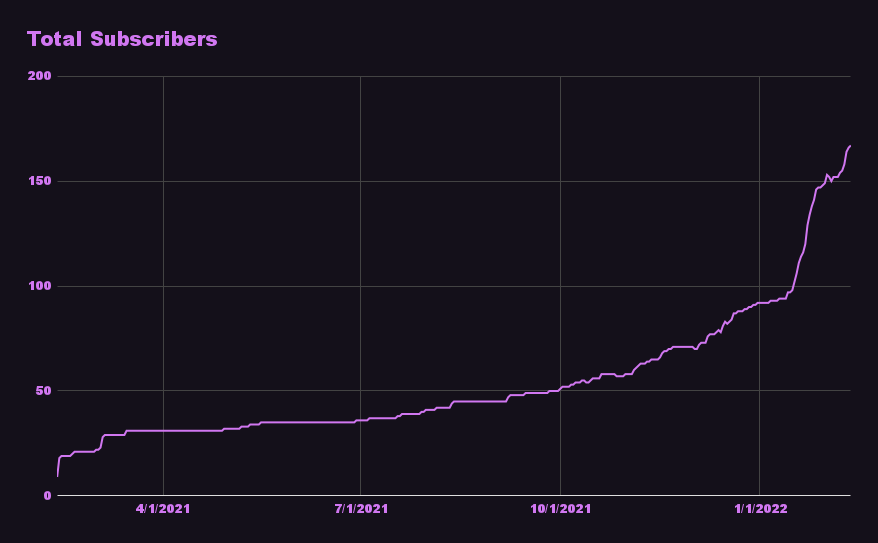
I didn't start Night Water with any kind of subscriber goal, though as the year went on, I did have the vague idea that reaching 100 subscribers would be nice. I ended up meeting that goal and then some, in large part thanks to a surge in January from a service called The Sample.
The Sample is a meta-newsletter that shares issues from other newsletters. I've been getting a trickle of subscribers from The Sample since I first submitted Night Water in August. I shared my referral link a few times in Substack writer forums. If someone signed up for The Sample as a reader using my link, The Sample would do their best to get Night Water as many subscribers as I sent over to them.
In January, they made a big change to the way this system works. Now, instead of just counting people who signed up as a reader, the referral system will also give you credit for anyone who submits their own newsletter after clicking your link. This gave me a massive boost almost overnight since most places I shared my link were writer forums. Of the 70 subscribers I got from The Sample in year one, 50 of them came from cross-promotion. 6 subscribers from The Sample have since unsubscribed—not a bad churn rate!
If you're a newsletter writer and haven't tried The Sample, I would definitely recommend submitting your newsletter (even if you don't use my referral link). Share your referral link with your own audience, or in any writer communities you're a part of. If your newsletter has a paid subscription, it may also be worth exploring The Sample's "paid forwards" feature—advertising, essentially, where you bid and pay per subscriber. By default, The Sample sends out the latest issue of your newsletter, but you can also pin a specific issue in your publisher dashboard. Go and play around with this—if you have a particularly great issue, it's worth putting your best foot forward to potential new subscribers. (Note that you can only choose from issues sent after you submit to The Sample.)
Where did the other subscribers come from? Many are personal friends or colleagues, or people I know at least somewhat personally. Other strangers have come from search traffic, which I'll dig into in the SEO section. A recent surge has come from a cross-promotional podcast project, which you'll hear more about in next week's Night Water.
Editorial Highlights
One could imagine, with the subscriber count going from 15 to 167 over the course of the year, that post views would follow a similar pattern upwards. And, upon review, that logical conclusion did turn out to be the case! But the trend line was a lot flatter than I expected.
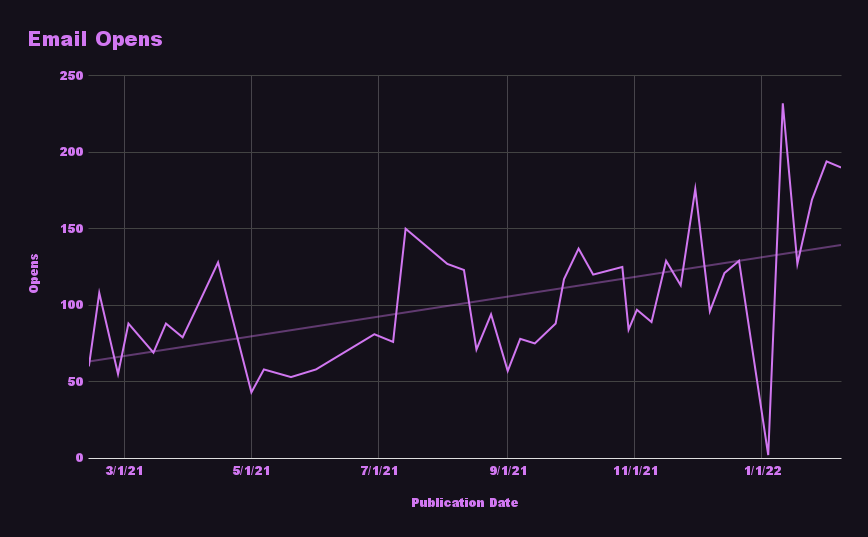
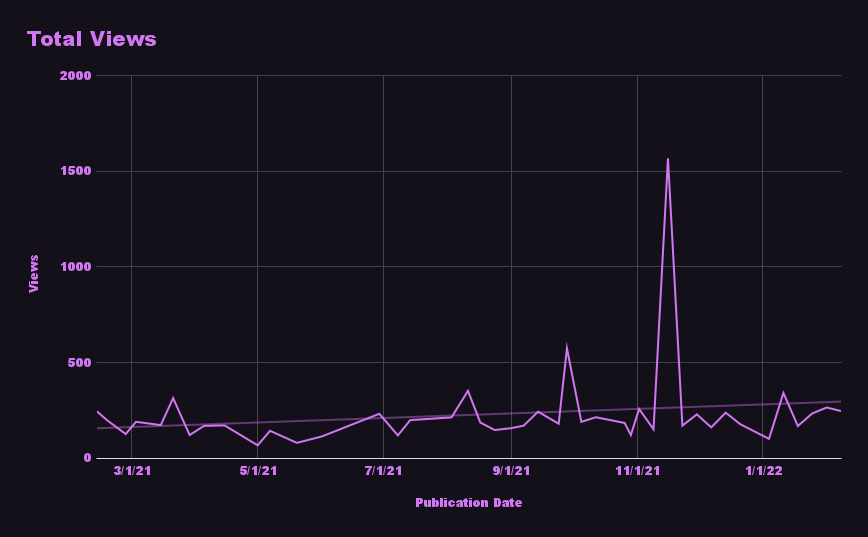
Here, I'm looking at two numbers: email opens—the number of times someone viewed the email version of the newsletter—and total views—an all-encompassing number that includes email opens as well as web views.
Unfortunately, Substack does not provide granular per-post traffic data, so without more careful tracking, it can be hard to see traffic growth for specific posts over time. However, we can compare total views and email opens to get a rough idea of which posts have a particularly robust post-email life (the idea here being that email views generally stop growing within a week or so of the post being sent out, while the web version can live on forever).
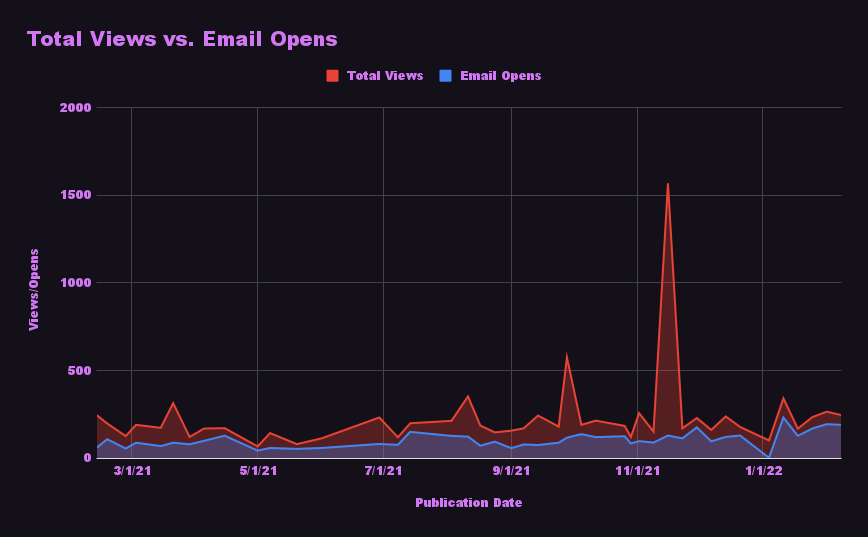
We see a lot of deviation between these two numbers in archive content, especially during months when there were very few email subscribers. As people have discovered Night Water, some readers are exploring the archive. Additionally, many articles have long-tail SEO value, which we'll get into in more detail in the next section.
So, without further ado, the top five Night Water posts from year one, based on total views between publication and the one year anniversary:
5) Everyone in this Airbnb commercial is dead (314 views, March 21, 2021)
An early hit! From what I can tell based on Substack's limited analytics, the majority of views on this one came from a combination of social traffic and Google searches. This post also got linked to in an article on the 30 best ads of the pandemic era, providing Night Water with one of its first good organic backlinks.
4) The Finn and Rey Cat Report Card (341 views, January 11, 2022)
The readers love my cats, what can I say? Almost 80% of traffic here came from email views, so I can only assume that Night Water subscribers demand more cat content.
3) It's time to bring back HitClips (352 views, August 11, 2021)
A personal favorite! My friend Drew sent me some HitClips after this article, and I actually think it's fine that we leave them in the early 2000s. 50% of the total views have come from search traffic at this point.
2) The Millions Visa Card turns your bank account into a lottery (575 views, September 28, 2021)
Another SEO success story, with 53% of traffic coming from search engines. I also happen to think it's pretty good!
1) Curling in Brooklyn has never been hotter (1568 views, November 16, 2022)
My first true blockbuster piece of content—at least, relative to the rest of my stats—with 32% of readers coming from Reddit (those curling subreddits are active as heck), 14% coming from other forms of social media, and around 43% coming from a combination of direct and search engine traffic. Besides the massive boost from Reddit, this post got a burst of traffic from Google's Discover feature, an algorithmically curated feed of articles that Google shows to mobile users. 127 readers came through Google Discover, mostly Canadian, natch. While the vast majority of readers came in the week after publication, some continue to trickle in through Google searches and backlinks from the Brooklyn Curling Center.
Search Engine Optimization
My first job out of college was writing SEO content for a fintech startup—blog posts designed to rank on Google for specific keywords. When it comes to Night Water, I don't necessarily craft my posts with SEO in mind. I don't do keyword research, I don't optimize my headings, I don't run anything through Yoast, etc. I'd rather write from an email-first perspective. But that doesn't mean I haven't taken steps to ensure that my posts are indexed and that Google sees Night Water as a trustworthy source.
I've seen writers in Substack's office hours complain about not ranking on Google who often have severe misunderstandings of SEO basics. Ranking on Google is not a one-time process; it's a long road that can take months or years to pay off, and even if you do end up ranking highly, you're competing against the entire internet and Google's algorithm to stay there. If you care about ranking and aren't familiar with SEO, it's worth reading through a few guides.
While Google, Bing, Yahoo, DuckDuckGo, and whatever other search engines you can think of all actively crawl the internet for new URLs to index, they aren't always particularly quick about it. The best way to make sure that Google indexes your site and new posts as quickly as possible is to verify your site in Google Search Console and submit your sitemap (or RSS feed).
Unfortunately, Substack has made this more difficult by taking away the ability to add the Google verification code in settings for newer accounts (if you still have it, you'll see a field for Google Site Verification under Advertising Analytics on your settings page). You can get around this by purchasing a custom domain for your Substack and verifying your site using your DNS record. However, Substack has also made the somewhat baffling decision to lock the ability to use a custom domain behind a $50 paywall—note that this is on top of what it will cost to purchase the domain from a third party.
But, assuming you go through all this trouble, Google will crawl your site much, much faster than if you wait for them to discover new pages organically. In fact, your new posts can start ranking the same day you post them—assuming Google sees them as quality results for queries. You can also verify your site in Bing Webmaster Tools—you can actually directly copy over your settings from Google Search Console. Bing search powers Yahoo and DuckDuckGo, so you'll have the vast majority of the search market covered if you submit a sitemap to both of these services.
The other major strategy I would suggest is to actively seek out backlinks. A backlink is just a link back to your website—hence the name. The more links back to your site, the more Google sees it as a trustworthy source. (This is, of course, simplified; the site linking back to you also has to be trustworthy. Shitty backlinks can actually signal to Google that your site is spam.) Backlinks can also help Google find and crawl your site if you're unable to verify in Search Console.
While it's very possible—in fact, ideal—to pick up backlinks organically, you can also seek them out. Some people search the web for articles on related topics, then email the authors to ask if they would include a link to their own article as a resource. Personally, I don't have the energy or time for that. My preferred way to try to pick up backlinks is Help A Reporter Out, a.k.a. HARO. HARO is a service that allows journalists to submit requests for sources—i.e. you! Sources get emails three times a day with long lists of these requests. If you have a good quote or information for a particular request, you can respond to it through HARO's site. If the journalist likes your answer and includes quote(s) from you in the article, they will often include a backlink to your site.
Most of these requests are for actual experts, so I'm a little limited in what I can reasonably respond to. However, the few backlinks that I was able to get through HARO have made a discernible impact on the amount of traffic I've seen from Google. Even just a few votes of confidence in your site can make a big difference for Google.
You can also build backlinks using sites that you control, or write guest posts for other people's sites. I've included a link to Night Water on my personal site, plus in my bios for the handful of external articles I've written this past year.
So, what have the results been for Night Water? In the last year, Night Water URLs have received over 69,000 impressions in Google search, leading to 623 clicks. 34,000 of those impressions and 317 of those clicks came in just the last 28 days. As I said, SEO is a long game.
34 Night Water URLs have received traffic from Google, but the majority of clicks were concentrated in the top 3. The Millions Visa Card post has received 261 clicks from Google—it ranks, on average, right under the official site when you search for "millions card" and other related keywords. While I wrote the post last September, it looks like Millions didn't start advertising the card to their larger market until last month, leading to a surge of people searching for reviews of the card. As far as I can tell, no one else has written about the card yet (or if they have, their SEO sucks), leaving Night Water as the sole beneficiary of that search traffic.
The next two heavy-hitters, with 82 and 65 clicks respectively, are my review of the Hey email service and my post on HitClips. The Hey article is interesting—most of the traffic has come from queries like "hey email calendar,” a pain point with the service that I noted in my review. I could've done a lot more to optimize the article for search; I have no intention of re-writing it, but I did add a subscribe button near the top to try to capture some of that search traffic.
The HitClips post has received the most search impressions of any Night Water post by far—over 39,000. Unfortunately, that's only translated to 65 clicks. I think there are two reasons for this. For starters, there's a lot more competition for HitClips keywords, as I'm hardly the first person to tackle the topic. And second, I think it's a victim of Google surfacing the post under their "People also ask" section. There, Google shows a snippet of the text on the page to show an answer to a specific question. That's great for people looking for that answer and less great for people coming to Night Water.
According to Substack's stat page, 11 email sign-ups have come from people clicking over from Google. I believe this includes not only search results, but the Google Discover traffic I noted for the curling article. This is roughly a 1.3% conversion rate—lower than I'd like, but given that this is all free traffic, I'm pretty happy with any sign-ups.
Looking ahead to Night Water: Year Two
I've already written way too many words at this point, but if you’ve made it this far, I might as well throw in a few more about what to look forward to in Year Two of Night Water.
As I wrote above, my primary goals are to publish something every single week and to have that something be an original piece of writing. I also think it'd be great to at least double the email list from 167 to 334 subscribers by next February. As a stretch goal, we can make that an even 500 on the free email list.
I'd also love to introduce some kind of paid option for the newsletter at some point this year. I have a pretty good idea of what this will look like, how much it will cost, and what the money will go towards funding. I'll leave all of that for a future post. For now, just know that the majority—a supermajority, you might say—of posts will continue to be free.
Thank you so much for reading Night Water. I love reading your comments and email replies and always appreciate it when someone reaches out to tell me they loved a particular post. Hope to see you all around the fridge for a refreshing glass of late night water next week.

